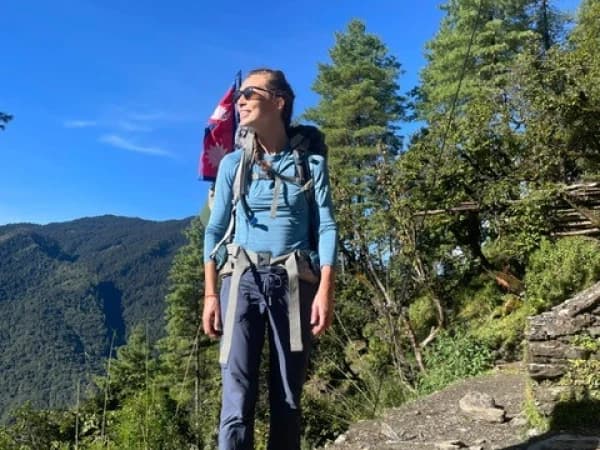Trek Overview
Helambu Trek is one of Nepal’s most accessible and culturally rich trekking routes, offering trekkers a fantastic combination of natural beauty, peaceful villages, and an introduction to the local Sherpa culture. Located just north of Kathmandu, Helambu is a hidden gem that provides a more tranquil trekking experience compared to other popular routes like the Annapurna or Everest regions. With its moderate difficulty level, it’s suitable for trekkers of all levels, especially those looking for a short yet rewarding trek.
The Helambu Trek lies in the Langtang National Park, in the central part of Nepal. The region is known for its lush valleys, dense forests, terraced fields, and stunning views of snow-capped peaks. The trek starts at Sundarijal, a mere 30-minute drive from Kathmandu, and meanders through charming villages like Chisapani, Tarkeghyang, and Melamchi Gaon. The trek reaches altitudes up to 3,650 meters (11,975 feet) at Tharepati and offers panoramic views of peaks like Langtang Lirung, Ganesh Himal, Gauri Sankar, and Manaslu.
The trail is a mix of subtropical forests, dense rhododendron woods, oak trees, and alpine meadows. As the trek ascends, the landscape changes dramatically, offering breathtaking mountain views along the way. The walk is generally on well-defined trails, making it a comfortable route, although some uphill stretches can challenge beginners.
One of the highlights of the Helambu Trek is the opportunity to experience the unique culture of the Sherpa people, who primarily inhabit the area. These people follow Tibetan Buddhism, and the trek offers a chance to visit various monasteries and stupas, providing an insight into their religious and cultural practices. Chisapani, the first stop on the trek, is known for its welcoming atmosphere and its traditional wooden houses. The village offers a great opportunity to interact with locals and observe their daily lives. Further along, Tarkeghyang is another Sherpa village where you’ll find a prominent Buddhist monastery and ancient artifacts. The villagers here still follow traditional farming methods, and their warm hospitality makes it a wonderful place to learn about Sherpa's life.
Additionally, you can visit Melamchi Gaon, a beautifully preserved Sherpa settlement with its distinctive houses and culture, located at a slightly higher altitude. This village offers superb views of the mountains, and trekkers can often interact with locals who practice agriculture, animal husbandry, and traditional crafts.
The trek offers stunning views of snow-capped peaks, including Langtang Lirung, Ganesh Himal, and Jugal Himal. The surrounding valleys and alpine meadows add to the beauty of the landscape. The chance to experience Sherpa culture, visit monasteries, and interact with local villagers adds a cultural dimension to the trek. Being close to Kathmandu, the trek doesn’t require a long journey to reach the starting point, making it perfect for trekkers who have limited time but want a trekking experience.
The trek takes you through dense forests filled with rhododendrons, pines, and oaks. Wildlife such as monkeys, Himalayan tahr, and various bird species are also common. With an average trek duration of 5 to 7 days, the Helambu Trek is relatively easy compared to other routes, making it a great option for beginners or those seeking a shorter trek.
The Helambu Trek offers a perfect blend of natural beauty, cultural immersion, and accessibility. With fewer crowds compared to the more famous trekking regions, it provides a serene and peaceful experience. Whether you’re a beginner trekker, a nature lover, or someone seeking a glimpse into the rich Sherpa culture, the Helambu Trek promises an unforgettable journey through some of Nepal’s most picturesque landscapes.
Highlights
- Panoramic views of peaks like Langtang Lirung, Ganesh Himal, and Jugal Himal.
- Visits to traditional Sherpa villages, monasteries, and cultural experiences.
- Lush forests, rhododendrons, and diverse wildlife.
- Proximity to Kathmandu, ideal for short treks.
- It is a relatively easy trek suitable for beginners with scenic trails.
What Can You Expect From Helambu Trek?
Panoramic vistas of the Langtang, Ganesh Himal, and Jugal Himal range. Interaction with local Sherpa communities, visits to Buddhist monasteries, and a chance to experience Sherpa culture.Lush forests, terraced fields, rhododendron blooms, and tranquil rivers.Fewer crowds compared to other popular trekking routes, offering a serene experience. It is a relatively easy trek with comfortable terrain, suitable for beginners and intermediate trekkers. Opportunities to spot wildlife like monkeys, Himalayan tahr, and various Bird species.
Who is Suitable for Trek?
The Helambu Trek suits beginner to intermediate trekkers, nature lovers, and those interested in Sherpa culture. It’s ideal for those seeking a short, scenic trek with moderate difficulty and easy access from Kathmandu.
Why Trek with Us?
Trek with us for expert guidance, personalized itineraries, safe travel, and professional support, ensuring a smooth and unforgettable trekking experience in Nepal’s beautiful landscapes.














